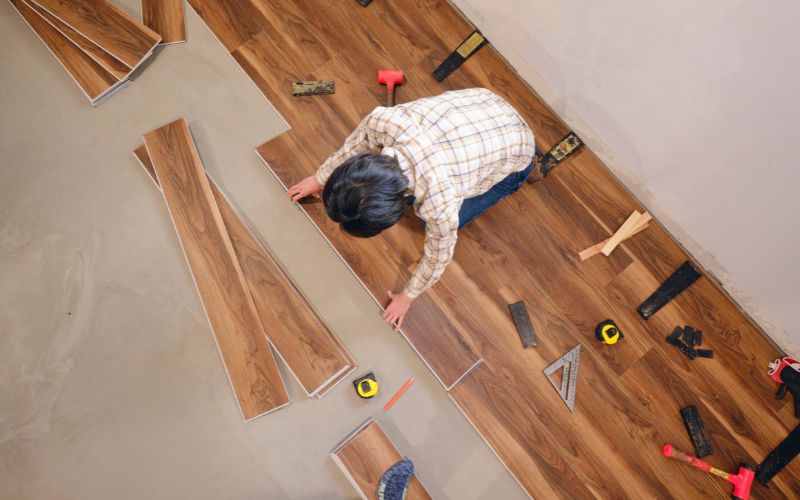Getting new floors installed is an exciting step toward transforming your home or business. But before your flooring contractor in Tempe, AZ arrives, there’s some prep work you’ll need to do to make sure everything goes smoothly. Preparing properly can help avoid delays, prevent damage, and make the process easier for everyone involved. Here’s a step-by-step guide on how to get your space ready for a flooring installation.
1. Clear the Room
The first thing you’ll need to do is clear out the room where the new flooring will be installed. This includes all furniture, rugs, and décor. Move couches, tables, and smaller items like lamps or picture frames out of the way. If you’re having flooring installed in multiple rooms, plan ahead for where you’ll temporarily store all your belongings.
For heavier items, like appliances or large furniture, you might need help moving them. Some flooring contractors offer moving services for an additional fee, but it’s a good idea to ask in advance. Clearing the space ensures that the installation crew has plenty of room to work.
2. Remove Old Flooring (If Necessary)
If your old flooring needs to be removed before installation, ask your contractor if they will handle the removal or if you need to do it yourself. While some contractors offer removal services, it’s always best to confirm.
For DIY removal, make sure you have the proper tools for the job. Depending on the type of flooring, you may need to pry up carpet, pull up tile, or carefully remove hardwood. Remember that removing flooring can create a lot of debris, so be sure to have trash bags or a dumpster ready to collect the old materials.
3. Check the Subfloor
The subfloor is the foundation on which your new flooring will be installed. A smooth, clean subfloor is essential for a successful installation. Once the old flooring is removed, inspect the subfloor for any damage like cracks, holes, or moisture.
If there are issues, let your flooring contractor Tempe AZ know right away so they can address them before installation begins. In some cases, the subfloor may need to be repaired or replaced to ensure your new flooring lays correctly and lasts longer.
4. Create a Dust-Free Zone
Flooring installation can get dusty, especially when cutting or sanding is involved. To minimize the mess, seal off the installation area from the rest of your home or business. You can hang plastic sheets or use painter’s tape to block doorways. This helps keep dust from spreading and protects your furniture and belongings in other rooms.
If possible, turn off the HVAC system during installation, as the dust can travel through vents and settle in other parts of your space.
5. Plan for Pets and Kids
Flooring installation can take a few hours to a few days, depending on the size of the space and the type of flooring. If you have pets or small children, it’s best to make arrangements for them to stay out of the way during the process. Not only can the installation be noisy and disruptive, but you don’t want anyone accidentally walking across unfinished floors.
Consider having a friend or family member watch your pets or kids, or keep them in a separate part of the house where they won’t interfere with the installation.
6. Double-Check the Schedule
Before installation day, confirm the schedule with your flooring contractor in Tempe, AZ. Make sure you know the start and end times, as well as how long the project is expected to take. Knowing the timeline helps you plan your day and prevents any surprises.
7. Prepare for Clean-Up
After the installation is finished, there’s usually some clean-up involved. While many contractors will handle basic clean-up, like removing scraps of flooring and dust, it’s a good idea to have a vacuum or broom ready for any final touches. If you had carpet installed, expect some shedding in the first few days, which is normal and will go away with regular vacuuming.
8. Give Time for Acclimation (If Needed)
For certain types of flooring, like hardwood or vinyl, the material may need to acclimate to the temperature and humidity of your home before installation. This usually means allowing the flooring to sit in the installation space for a day or two. Your flooring contractor will let you know if this step is necessary, but it’s something to keep in mind when planning the timeline for your project.
Conclusion
Preparing for a flooring installation takes a bit of effort, but it’s worth it to ensure the process goes as smoothly as possible. By clearing the space, checking your subfloor, and making sure your home or business is ready for the installation crew, you’ll be setting the stage for a successful and stress-free project. When you work with a trusted flooring contractor in Tempe, AZ, you can rest assured that your new floors will look great and last for years to come.





Comments